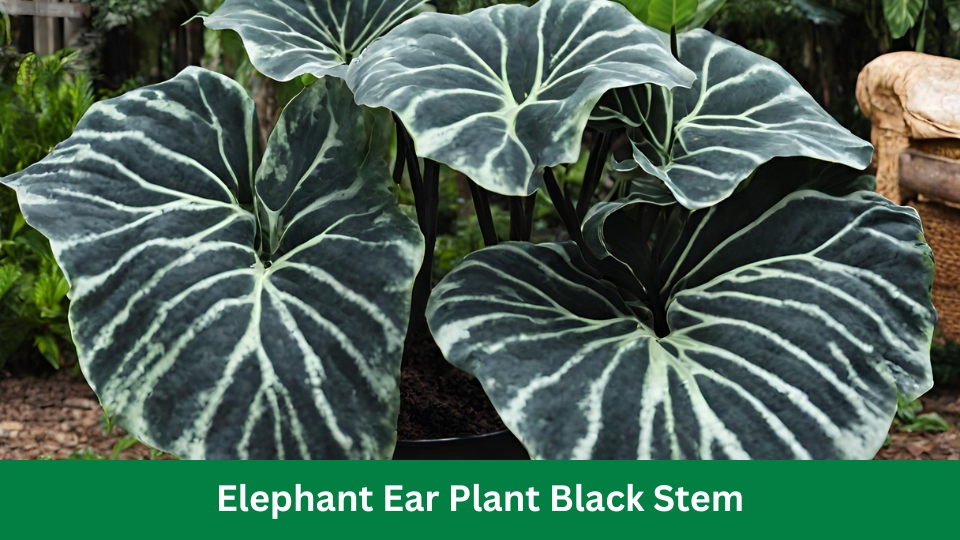Elephant ear plant black stem is a symptom indicating a possible disease or environmental issue. The stem turns black due to diseases like root rot, fungal infections, bacterial infections, overwatering, lack of drainage, or cold temperatures.
These issues can lead to root damage, hinder nutrient absorption, and weaken the plant. Identifying and promptly addressing the underlying cause can save the plant and restore its health.
Elephant Ear Plant – A Closer Look
The elephant’s ear plant, scientifically known as Colocasia Esculenta, is popular among indoor and outdoor gardeners. Its striking dark stems create a captivating visual contrast to its lush, vibrant green foliage.
Our discussion in this section will cover the characteristics and description of elephant ear plants, some of their popular varieties, and the cultivation requirements necessary for their growth.
Description And Characteristics
The elephant ear plant gets its name from its enormous heart-shaped leaves that resemble elephant ears. These leaves can grow up to 3 feet long and 2 feet wide, making them a stunning centerpiece in any garden or indoor space. The plant’s stems are one of its most distinctive features, with a deep black color that adds drama to its overall appearance.
One key characteristic of the elephant’s ear plant is its rapid growth. Under optimal conditions, it can grow up to 6 feet tall in a single growing season. This fast-growing nature, impressive size, and distinctive foliage make the elephant ear plant a standout choice for gardeners seeking a bold, tropical look.
The elephant ear plant is known for its ability to thrive in various climates and conditions. While it is native to tropical and subtropical regions, it adapts to different environments, making it suitable for indoor and outdoor gardening. Its versatility extends to growing in containers or directly in the ground.
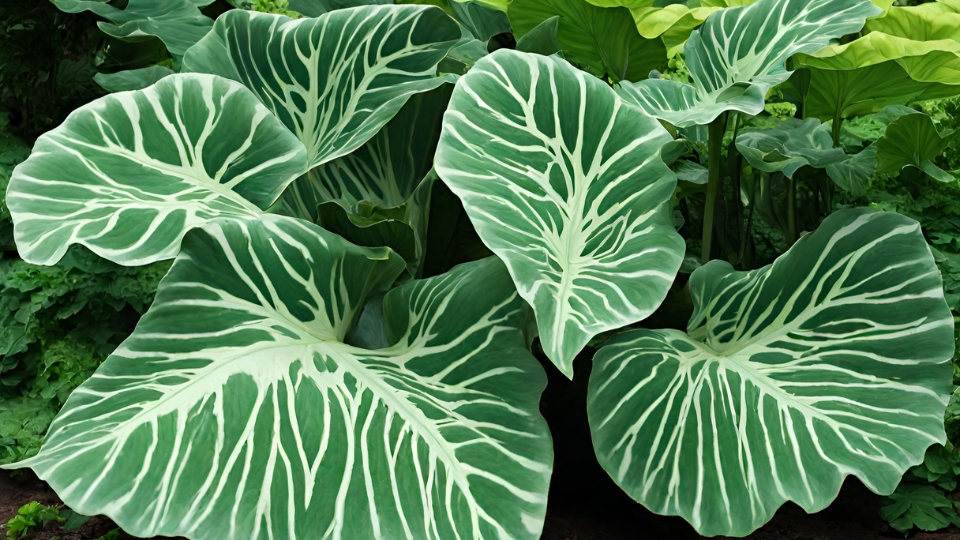
Popular Varieties
There are several popular varieties of the elephant ear plant, each with its unique aesthetic appeal. Let’s take a closer look at some of these:
| Variety | Description |
|---|---|
| Alocasia ‘Polly’ | This variety features glossy, deep green leaves with prominent white veins. |
| Colocasia ‘Black Magic’ | With its dark purple-black leaves, this variety adds a touch of mystery to any garden. |
| Caladium ‘White Queen’ | This variety stands out with its pale green leaves adorned with delicate white markings. |
Cultivation Requirements
Successfully growing and caring for the elephant ear plant requires attention to its cultivation requirements. Here are some key factors to consider:
- Light: The elephant ear plant thrives in bright, indirect light. While it can tolerate some shade, providing it with at least 6 hours of sunlight each day is best.
- Water: Adequate water is crucial for the healthy growth of the elephant ear plant. Keep the soil moist but not waterlogged, as excessive moisture can lead to root rot.
- Soil: This plant prefers well-draining soil rich in organic matter. A mix of peat moss, perlite, and compost works well.
- Temperature and Humidity: The elephant ear plant thrives in warm and humid conditions. Maintaining a temperature range of 65-85°F (18-29°C) and humidity levels around 50-60% will promote optimal growth.
- Fertilizer: Regular feeding with a balanced, water-soluble fertilizer will provide the nutrients for the elephant ear plant’s healthy development.
With proper care and attention to its cultivation requirements, the elephant ear plant can bring a touch of the tropics to any garden or indoor space. Its striking black stems and large tropical leaves will make a lasting impression.
Understanding Black Stems In Elephant Ear Plants
Black stems in elephant ear plants can cause concern for many gardeners and enthusiasts. Understanding the reasons behind black stems is crucial to maintaining their health and vitality.
Here, we will determine why black stems occur in elephant ear plants, their significance, and how anthocyanin pigments play a role.
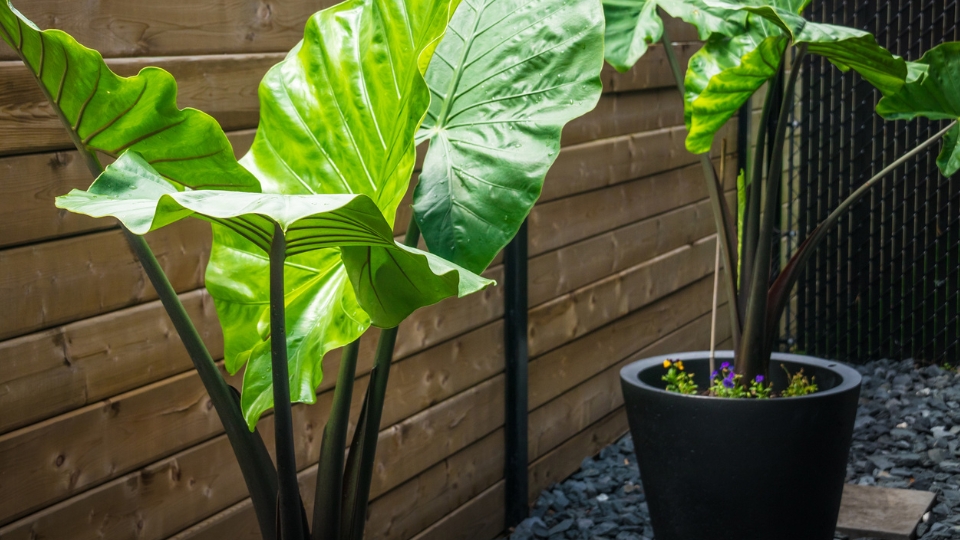
What Causes Black Stems?
Black stems in elephant ear plants can be attributed to various factors, including:
- Fungal infections: Certain fungal pathogens can infect the stems of elephant ear plants, leading to black discoloration.
- Overwatering: Excessive moisture can cause the roots of elephant ear plants to become waterlogged, leading to rot and eventual blackening of the stems.
- Poor drainage: Inadequate drainage in the pot or planting area can result in stagnant water, creating conditions favorable for black stem development.
- Frost or cold damage: Exposure to extreme cold or frost can cause the stems of elephant ear plants to turn black.
- Physical injury: Any mechanical damage, such as cuts or bruises, can disrupt the plant’s vascular system, resulting in black discoloration.
Significance Of Black Stem In Plants
Black stems in elephant ear plants should not be overlooked, as they may indicate underlying problems or imbalances in the plant’s health. Here are a few reasons why black stems are significant:
- Early warning signs: Black stems can serve as early indicators of plant stress or diseases, enabling gardeners to take timely action and prevent further damage.
- Reduced nutrient uptake: Blackened stems may disrupt the plant’s ability to transport vital nutrients, depriving it of the nourishment necessary for optimal growth.
- Aesthetics: The darkened appearance of black stems contrasts with the vibrant leaves of elephant ear plants, potentially impacting their overall visual appeal.
- Plant mortality: If left untreated, black stem issues can escalate and eventually lead to the death of the plant.
Role Of Anthocyanin Pigments
Anthocyanin pigments are crucial in the black discoloration seen in elephant ear plant stems. These natural pigments, responsible for vibrant colors in plant tissues, can accumulate in response to various stressors, resulting in the characteristic black coloration.
Anthocyanins protect the plant from harmful ultraviolet (UV) radiation and have potential antioxidant properties, helping the plant combat oxidative stress caused by environmental factors.
However, it is critical to note that while anthocyanin pigments contribute to black stems, their presence does not necessarily indicate plant health.
The Stunning Power Of Dark Foliage
When creating an eye-catching and dramatic garden, nothing quite compares to the stunning power of dark foliage. This section will explore the visual appeal and aesthetic value of elephant ear plants with black stems, the key factors to consider when choosing the right plant for dramatic foliage, and how to pair them with other plants for maximum contrast.
Let’s dive in and discover the beauty that dark foliage can bring to your garden.
Visual Appeal And Aesthetic Value
Dark foliage plants, such as the elephant ear plant with black stems, offer a unique visual appeal that instantly captures attention. The contrast of the dark color against vibrant green or other light-colored plants creates a striking display. Rich tones add depth and sophistication to any garden or indoor space. Whether you have a contemporary garden design or prefer a traditional look, these plants seamlessly blend into various styles. They bring elegance and mystery.
Additionally, dark foliage plants have aesthetic value beyond their visual impact. They create drama and intrigue, becoming focal points in any landscape. From a distance, the dark leaves create a captivating backdrop for other plants, enhancing their colors and textures. Up close, the leaves detailed veining and glossy sheen add a luxurious feel to the overall ambiance. They will state whether they are used as standalone specimens or integrated into a broader planting scheme.

Choosing The Right Plant For Dramatic Foliage
When choosing an elephant ear plant with black stems for its dramatic foliage, there are a few key factors to consider. First, ensure the plant suits your specific climate and growing conditions. Some varieties thrive in full sun, while others prefer partial shade or indoor environments. You can ensure optimal growth and foliage development by selecting the right plant for your location.
Another consideration is the plant’s mature size. Elephant ear plants can vary in height and spread, so it’s essential to plan accordingly to prevent overcrowding or overshadowing other plants in your garden. Additionally, considering your garden’s overall color scheme and design will help you choose a plant that complements the existing elements. This brings harmony to the space.
Pairing With Other Plants For Contrast
To truly make the most of the stunning power of dark foliage, consider pairing your elephant ear plant with black stems with other plants that provide contrast. Choose plants with lighter or brighter foliage to create a striking visual balance. For example, pairing the dark foliage with plants with variegated leaves or vibrant flowers can create a captivating display.
In addition to color contrast, consider contrasting textures and forms. Pairing the bold, large leaves of the elephant ear plant with slender, feathery ferns or delicate grasses can create a visually dynamic arrangement. Contrasting shapes and textures add interest and depth to your garden.
Remember to allow enough space for each plant to grow and show its unique characteristics. Proper spacing ensures optimal growth, allowing each plant to shine and contribute to your garden’s overall beauty.
Common Challenges With Elephant Ear Plant Black Stems
Growing elephant ear plants can be rewarding for gardeners, but not without challenges. One of the most common problems with these plants is the development of black stems. As discussed in this section, several factors can contribute to black stems on elephant ear plants.
Diseases And Pests
One of the leading causes of black stems in elephant ear plants is the presence of diseases and pests. Certain fungal infections, such as black rot or stem rot, can attack the stems, causing them to turn black and eventually decay. Additionally, pests like aphids, mealybugs, or scale insects can damage the stems, leading to discoloration.
Identifying and addressing these issues promptly is crucial to prevent further damage and potential spread to other parts of the plant.
Environmental Factors
The environment in which the elephant ear plant is grown plays a significant role in its stem health. Excessive moisture due to overwatering or poor drainage can lead to root rot, affecting the stems and causing them to turn black.
On the other hand, insufficient watering or dry conditions can also stress the plant, resulting in discoloration. Maintaining healthy stems is essential to finding the right moisture balance and drainage.
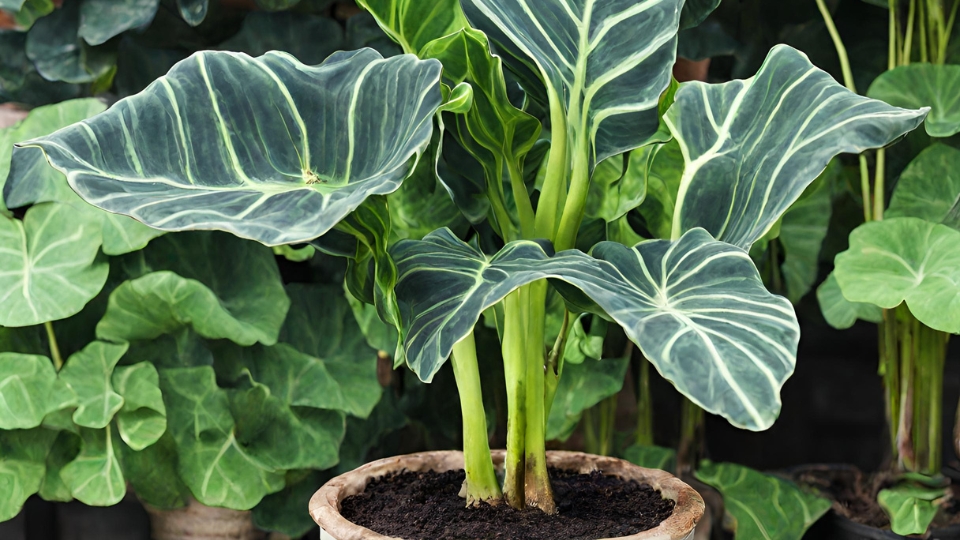
Applying Proper Care And Maintenance
Proper care and maintenance are crucial for preventing the development of black stems in elephant ear plants. Here are a few important care tips to keep in mind:
- Plant in well-draining soil: Ensure the plant is potted in soil that allows excess water to drain properly, minimizing the risk of root rot and black stems.
- Regularly inspect for pests: Routinely check the plant for any signs of pests like aphids or scale insects. If detected, take necessary steps to control and eliminate them.
- Monitor watering: Avoid overwatering or underwatering by periodically checking the moisture levels in the soil. Water when the top inch of soil feels dry, but avoid waterlogging.
- Provide adequate light: Elephant ear plants thrive in bright, indirect light. Ensure they receive enough sunlight to promote healthy growth and avoid stress.
- Prune-damaged stems: If you notice any black stems, promptly remove them using sterile pruning shears. This helps prevent the spreading of diseases or pests to other parts of the plant.
Following these care tips and promptly addressing any issues can ensure your elephant ear plant stays healthy and free from black stems.
Caring For Elephant Ear Plants With Black Stems
If you’re the proud owner of elephant ear plants with black stems, it’s essential to understand how to care for these stunning tropical plants properly. You can ensure their health and promote their growth by providing sunlight, optimal soil conditions, and proper watering and fertilization.
This section will discuss various care tips for your elephant ear plants with black stems.
Sunlight And Shading Requirements
Sunlight plays a crucial role in elephant ear plant growth. These plants thrive in bright, indirect light, so placing them in a location that receives filtered sunlight for most of the day is crucial. Avoid exposing them to direct sunlight, as it can scorch their leaves and cause damage. If your plant’s leaves turn yellow or brown, it may indicate overexposure to sunlight.
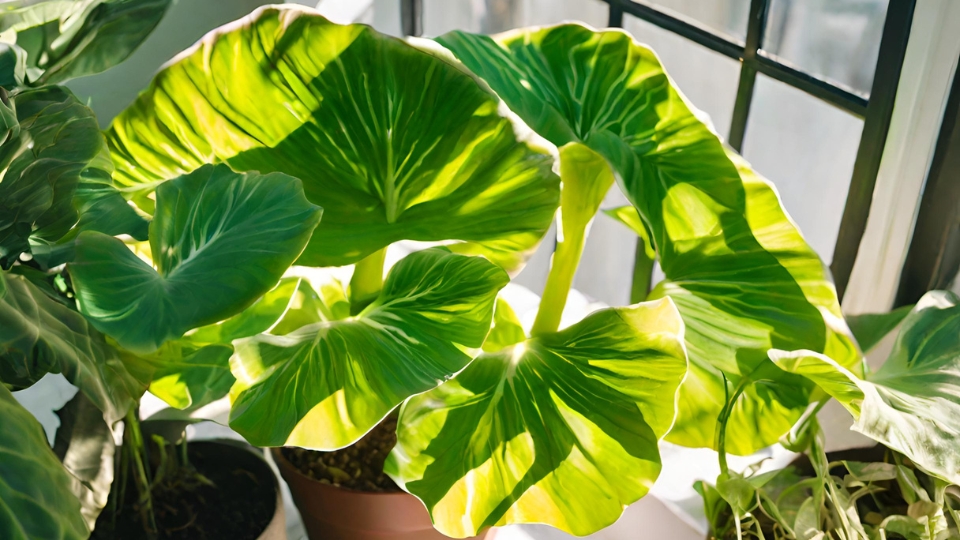
Optimal Soil Conditions
Proper soil conditions are vital for elephant ear plants with black stems. These plants prefer well-drained, fertile soil rich in organic matter. A mixture of peat moss, perlite, and loamy soil can provide the ideal growing environment for them. Ensure soil moisture levels are maintained, as overly dry or waterlogged soil can lead to root rot.
Watering And Fertilization Tips
When watering elephant ear plants, striking the right balance is essential. Keep the soil moist but never waterlogged. Be sure to water thoroughly when the top inch of soil feels dry. During the warmer months, you may need to water more frequently, but always allow excess water to drain away.
Fertilizing your elephant ear plants is crucial to their growth and health. Use a balanced, water-soluble fertilizer once a month during the growing season. Dilute the fertilizer according to the manufacturer’s instructions and apply it directly to the soil. Avoid over-fertilizing, as it can cause leaf burn or nutrient imbalances.
| Aspect | Requirement |
|---|---|
| Sunlight | Bright, indirect light |
| Soil | Well-draining, fertile soil with organic matter |
| Watering | Consistently moist soil, but never waterlogged |
| Fertilization | Use a balanced, water-soluble fertilizer once a month |
Following these care tips, you can ensure that your elephant ear plants with black stems thrive and become a stunning addition to your indoor or outdoor space. Monitor their sunlight exposure, provide them with well-draining soil and water, and fertilize them appropriately. With proper care, your elephant ear plants will reward you with their vibrant foliage and striking beauty.
Propagation Techniques
Propagation techniques are essential for expanding your collection of Elephant Ear plants with black stems. Below, we will explore three effective methods for propagating these stunning plants: division, stem cuttings, and offset bulbs.
Division
The division is a straightforward and reliable way to propagate Elephant Ear plants with black stems. This technique involves separating a mature plant into several smaller plants, each with its roots and foliage.
To successfully divide an Elephant Ear plant, follow these steps:
- Determine the best time to divide the plant, typically during the early spring or late winter.
- Carefully remove the plant from its pot or garden bed, and gently loosen the roots.
- Inspect the rhizome, the thick underground stem that stores nutrients, and locate natural divisions or sections where you can separate it.
- Make precise cuts to separate the rhizome into multiple sections using a clean, sharp knife or shears. Ensure that each section has at least one or two healthy-looking buds.
- Optionally, dust the cut edges with a rooting hormone to encourage faster root development.
- Plant each divided section in a suitable container or directly into the ground, ensuring the buds are facing up and covered with soil.
- Water the newly planted sections thoroughly and place them in a warm and bright location, away from direct sunlight.
Stem Cuttings
Propagating Elephant Ear plants through stem cuttings is another effective technique. This method involves taking a section of the stem from a mature plant and encouraging it to grow roots and develop into a new plant.
To propagate Elephant Ear plants through stem cuttings, follow these simple steps:
- Select a healthy stem from the parent plant, ideally with multiple nodes or areas where leaves emerge.
- Cut the stem below a node using a clean and sharp knife, ensuring the cutting is approximately 6 inches long.
- Remove any bottom leaves from the cutting, leaving a few intact near the top.
- If desired, dip the cut end of the stem into a rooting hormone to encourage quicker root development.
- Place the cutting in a container with well-draining soil and provide consistent moisture.
- Position the container in a warm and bright location, avoiding direct sunlight.
- After a few weeks, roots should start to form, indicating successful propagation. At this point, you can transplant the new plant into its permanent container or garden bed.
Offset Bulbs
Offset bulbs are a natural method of propagation that Elephant Ear plants utilize to reproduce. These bulbs, often called “pups” or “offsets,” grow alongside the main bulb and can be separated to create new plants.
To propagate Elephant Ear plants using offset bulbs, follow these straightforward steps:
- Identify the offsets growing near the main bulb. These are typically smaller bulbs connected to the parent bulb by a short stem.
- Gently remove the offsets by carefully untangling their roots from the parent bulb.
- Inspect each offset to ensure it has its own set of roots and leaves.
- Plant each offset bulb in a suitable container or directly into the ground, ensuring the roots are covered with soil and the foliage above the surface.
- Water the newly planted offsets thoroughly and place them in a warm and bright location.
- Monitor the offsets’ growth and provide adequate care until they become independent plants.
By employing these propagation techniques, You can multiply your collection of Elephant Ear plants with black stems by division, stem cuttings, and offset bulbs. Whether you prefer the straightforward division method, the simplicity of stem cuttings, or the natural occurrence of offset bulbs, choose the method that best suits your preference and experience level.
Frequently Asked Questions On Elephant Ear Plant Black Stem
How Do You Take Care Of Elephant Ears With Black Stems?
To care for elephant ears with black stems:
– Provide bright, indirect sunlight.
– Water consistently, keeping the soil moist but not waterlogged.
– Use well-draining soil to prevent root rot.
– Ensure proper humidity levels, as elephant ears prefer high humidity.
– Remove any dead or dying leaves regularly for healthy growth.
Are Black Stem Elephant Ears Rare?
Black-stem elephant ears are considered rare due to their unique feature of dark-colored stems. Collectors highly seek after these plants for their striking appearance.
Why Is My Elephant Ear Plant Turning Black?
Your elephant ear plant may be turning black due to overwatering, which can cause root rot. Ensure proper drainage and let the top layer of soil dry out before watering again. Light levels and temperature extremes can also contribute – ensure the plant is in a suitable environment.
Conclusion
To sum up, the black stem of an Elephant Ear Plant is a visual cue of potential issues, such as overwatering or insufficient sunlight. By recognizing and addressing these problems promptly, you can ensure your plant’s overall health and vitality.
Please pay attention to its care requirements, provide proper drainage, and maintain a balanced watering schedule to maintain a vibrant green stem. With careful attention and regular maintenance, your Elephant Ear Plant will thrive and bring beauty to your indoor or outdoor space.
Video Source: https://www.youtube.com/watch?v=a4uPb79-Zec

